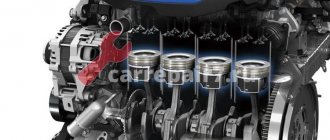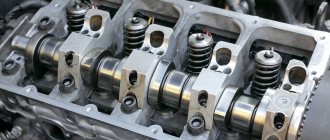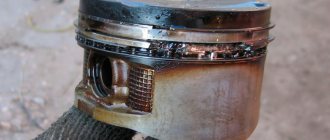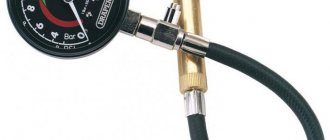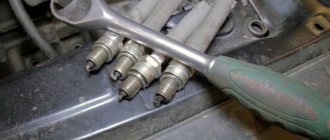The engine does not warm up to operating temperature: causes and diagnosis of the problem
Car owners often encounter a problem where the engine does not heat up to operating temperature.
Usually they do not pay attention to it right away, since not everyone knows why low engine temperature is dangerous. For normal operation, 100 degrees is required. The question is why the engine does not heat up well and becomes hot when cold weather sets in, when it is not comfortable to be inside the car due to the low temperature. In addition, consumption increases significantly, the engine wears out faster, the car drives worse, and the level of toxic substances in the exhaust gases increases.
The engine takes a long time to warm up - when should you be nervous?
It is quite possible that the engine takes a long time to warm up due to the fact that the car has such design features. For a VAZ 2107, for example, it will be difficult to move away in cold weather if the car does not run in warm-up mode for up to 5 minutes. The same story applies to old VAZ 2114 engines and many other representatives of this manufacturer. You need to worry about the condition of the car if there are such features:
- Previously, the engine warmed up much faster, but now to start normal operation you have to stand for long minutes and listen to the uneven revolutions of the unit and the dead temperature needle;
- when warming up, unprecedented symptoms began to appear - the speed fluctuates too much, the voltage in the on-board network drops, the car stalls or other anomalies occur;
- when you start driving, you feel a significant lack of power, the engine tries to pull out under load, it seems that you are dragging a heavy trailer behind you;
- when starting, you have to turn the starter for too long, warming up occurs at low speeds, the engine constantly works as if under a heavy load, and the consumption is simply enormous;
- The engine does not reach operating temperatures even after several hours of operation; this also indicates problems that should be eliminated for a normal trip.
How does the engine warm up?
Each serviceable unit has a different warm-up time. It is influenced by:
- degree of forcing;
- engine type: diesel or gasoline;
- cooling system condition;
- stove operation;
- quality of antifreeze or antifreeze;
- work load;
- outside air temperature;
- type and viscosity of engine oil.
The characteristics of the oil are rarely taken into account, but experts believe that this is necessary. Various friction reducing additives and the base stock, synthetic or semi-synthetic, affect the performance in the range of 5–7 degrees. Thus, the engine will heat up faster with thinner synthetic oil.
The engine temperature gauge does not rise often due to a malfunction of the thermostat. It is with this unit that the system check always begins if the engine takes a long time to warm up to operating temperature.
Getting started with the car
One of the important nuances when operating a car is preparing it for movement. First of all, this applies to working with the engine. First, before starting to move towards the intended goal, it is necessary to prepare the engine for its active operation during movement, that is, it should be warmed up. After a long period of inactivity, which is a period of more than 3-4 hours in summer, and 1-2 hours in winter, the engine temperature drops to a minimum value. In order to avoid many problems, you need to start the car and wait until the engine temperature sensor reaches at least 50 degrees. If you like to drive a cold engine, then be prepared for increased oil consumption, which in turn will lead to faster engine wear and additional costs for consumables.
Drivers often face the problem of taking a long time to warm up the engine, especially in winter. Waiting takes up a lot of time, and you don’t really want to sit, for example, in a cold car in winter. In this case, it is worthwhile to figure out why the engine takes a long time to heat up and whether this is a consequence of any malfunction in its operation.
Similar article - Why you can’t create a perpetual motion machine
Principle of operation
Coolant enters the radiator through the thermostat. This is a large circle of fluid circulation. The thermostat usually opens at a temperature of 100 degrees Celsius. If the temperature has not reached this limit, then the liquid moves in a small circle. A thermostat malfunction is manifested by improper opening of the valves.
When the thermostat is closed, the engine overheats, and a constantly open one leads to low temperatures, since the liquid will only flow in a large circle.
Due to irregular changes of antifreeze or antifreeze, use of running water or mixing of coolants, various deposits in the form of scale may accumulate in the system. In this case, the thermostat will inevitably jam in one of its positions.
Checking the Thermostat
To diagnose the malfunction, you should contact a service specialist. However, you can check the thermostat yourself. The cold engine is allowed to idle for approximately 10 minutes. After this, you need to check the radiator pipes. If the thermostat is functioning properly, the hoses will not become hot. The temperature rises only at the moment when the coolant begins to circulate in a large circle.
The coolant enters the large circle only after reaching operating temperature. If the pipes begin to heat up before the specified point, you should immediately contact a technician for further diagnosis and troubleshooting. There are also more professional diagnostic methods using special sensors. Such a check can be carried out at a service station.
If the device does not open and close completely, partial overheating may occur or the temperature will rise, but very slowly. Also, the wedge can be observed only periodically.
Any specified defect requires careful examination and repair. If you do not have the necessary skills and minimal knowledge about the internal structure of a car, you should contact qualified car service specialists.
To remove the thermostat, you must first get rid of the liquid in the system. It is important to wait until the entire system has cooled down before replacing the part. Removing the thermostat is quite simple; to do this, just unscrew the three bolts located on the cover and remove it together with the thermostat.
Taking into account all the design features of this model, it can be replaced with an identical or suitable analogue. Well-known brands produce units that can be interchanged, so there are no difficulties with selection. In any case, all manipulations must be carried out by a person who knows exactly what needs to be done, takes into account the make, year of manufacture, and mileage of the car.
It is very important to consider that the cost of this part is quite low, so it would be more appropriate to replace it than to repair it. Thus, you can get rid of problems with low engine temperature for the entire winter season.
Since when replacing the thermostat you will have to drain the fluid, it is worth checking the engine for performance before the start of the winter season. Many car owners pour antifreeze into the system and then face the need to replace the unit, therefore paying twice for the coolant.
Checking the functionality of the thermostat yourself
When the engine temperature drops unreasonably while driving, you will need to dismantle this element, prepare a container with liquid, place the device there and find out at what temperature the valve will open. If this does not happen, there is a malfunction.
To carry out work on removing any mechanisms, you need to have an understanding of their structure. Otherwise, other unplanned problems may arise. If you have no idea about the structure of the mechanisms, then you should contact specialists who perform this work efficiently. They will additionally give some useful tips and answer any questions you may have.
Source
What can be dangerous about a cold engine?
If you notice that the engine has not warmed up to operating temperature and it cannot rise, then you should start immediately troubleshooting, as the consequences can lead to serious expenses for repairs.
The electronic control unit installed on modern cars recognizes an unheated engine as a cold one. If it cannot warm up and the engine temperature does not rise, then an over-enriched mixture is supplied.
When the system has to operate in this mode, the spark plugs fail due to the appearance of carbon deposits on them and on the internal elements. Thus, you can significantly reduce the service life and face major repairs, which cost a lot of money.
If the engine does not warm up to operating temperature, you should immediately contact a car service to diagnose the problem so that similar malfunctions do not occur in the future.
What causes a decrease in temperature
Any equipment is not immune from failure of some components and assemblies. It is necessary to pay attention to the condition of the machine and its systems. An unpleasant situation when the engine temperature drops while driving is due to malfunctions of the cooling system elements. To understand the essence of the problem, it is necessary to have a general understanding of how the power plant is cooled.
It is necessary to monitor the coolant level and the condition of the connecting pipes and the radiator itself. The system has small and large cooling circuits. The difference is that a complete circulation circuit drives the fluid through the radiator. The mechanism that switches the circuits is called a thermostat. Situations where the engine temperature does not rise often occur in winter. Rarely, the working fluid status indicator on the instrument panel is faulty. It is possible to use some materials for insulating the power plant.
Effect of motor oil
As you know, engine performance depends on the quality of the oil. The degree of heating of the engine will depend on this, especially in winter. Depending on what kind of oil is used (synthetic or semi-synthetic), the engine may heat up differently, and the range of fluctuations in coolant temperature will be from 5 to 20 degrees.
Depending on how liquid the motor lubricant is, how well and quickly the engine will start in winter, as well as the degree to which it heats up quickly. Therefore, it is recommended to fill only high-quality oil into the engine before winter.
Engine temperature sensor
On modern cars, coolant and oil temperature sensors are often installed instead of a thermostat. Depending on the obtained indicators, the automation releases antifreeze in a large and small circle, ensuring quick warm-up of the engine and subsequent maintenance of the optimal engine temperature. If the temperature sensor fails, then the automatic system, in order to prevent engine overheating, immediately releases antifreeze in a large circle, turning on the fan at full power.
Identifying such breakdowns is not difficult. You can conduct computer diagnostics, which will allow you to determine errors in temperature sensors or see how the engine operates when cold. If the fan turns on immediately after starting the engine at full power, then this is the main symptom of a malfunction. It is necessary to replace the failed sensor by calibrating it to the characteristics of a particular motor. The cost of such repairs will vary depending on the car model.
Other reasons
A malfunctioning thermostat may not be the only reason why the engine does not reach operating temperature.
If the pipes were not tightened well during the previous repair, the car owner is faced with air leaks. Coolant begins to leak. If this is the problem, then you should tighten the clamps for a tighter fit of the tubes and add fluid to the required level in the expansion tank.
In this case, the car owner will see a low temperature on the dashboard, which is insufficient for operation. In fact, the engine will overheat and may even boil.
During the winter season, engine performance is also affected by the use of other systems. So, using a cabin heater can lead to the engine not heating up well, since the stove takes some of the heat onto itself. In this case, you will see how the arrow of the engine temperature indicator drops.
A faulty temperature sensor can cause the engine to feel like it takes a long time to warm up or may not heat up at all. In this case, the engine works properly. The sensor transmits temperature status data to the dashboard. If it does not work correctly, then the readings will be incorrect. Replacing this part will bring all indicators back to normal.
The problem with the sensor is quite serious on modern cars equipped with electronics. Here again you will have to deal with supplying an over-enriched mixture and replacing many other parts.
Any problem that arises must be resolved with the help of a competent specialist. If you do not have the necessary knowledge and skills, you should contact a car service center. Experienced technicians will help eliminate the problem and prevent its occurrence in the future.
Why does the engine get hot?
The main reason for the increase in engine temperature is considered to be a malfunction of the radiator. Its main task is to ensure normal engine cooling. This task is difficult to cope with if the walls of the radiator are covered with scale or dirt. If the engine overheats on a busy highway and you have caustic soda on hand (it can be found in any boiler room), then you can “revive” the engine on your own.
First, you need to stop as quickly as possible and turn on the stove at full power. This will reduce the temperature inside the propulsion system. Secondly, a soda solution (50 g per 2 liters of water) should be poured into the radiator and run the engine for 15-20 minutes. Such actions will help rid the radiator walls of adhering dirt and excessive scale.
Video tutorial on why the engine gets hot
Thus, the following reasons for engine overheating can be identified:
- Insufficient fluid level in the vehicle's cooling system. This is the most popular reason for motor failure. In order to prevent critical situations, it is necessary to carefully monitor her condition before the next trip.
- Insufficient air cooling level. This may be caused by the fan not running at full power. The main reason is the weakening of the transmission belt. A particularly common problem in Kalina.
- Incorrect fuel injection adjustment. The engine is started by getting gasoline into the internal combustion engine chamber. At this moment, a spark is supplied, which increases the temperature inside the engine due to an increase in the amount of exhaust gases. A malfunction of this system can result in engine valves not opening at the right time. As a result, the likelihood of overheating of the cylinder head increases, which manifests itself in a decrease in engine power.
Why does the engine not warm up to operating temperature?
Proper operation of an automobile internal combustion engine is possible only at an operating temperature of about 90 degrees Celsius. After the engine starts and the air-fuel mixture begins to burn, the engine heats up sharply, and the cooling system takes on the task of cooling it. If the cooling system is faulty, the engine may overheat, which negatively affects the units and components of the engine: excessive wear of parts occurs, the lubricant loses its properties, engine elements may begin to stick and jam, and other problems may occur. An equally serious problem is when the engine does not warm up to operating temperature.
Elimination methods
When all the reasons have been identified, you can proceed directly to considering the issue of repairing the power unit. Before proceeding directly to the operations, it is worth understanding the design and operation of the motor components, as well as having an understanding and repair skills. Let's arm ourselves with tools and go!
Thermostat
The most common reason why the engine does not warm up is the thermostat. One of the elements that can fail at the most unexpected moment and determining the service life of the part is beyond the control of even the manufacturer.
Structurally, it turned out that the cooling system has two circles - large and small. When the thermostat is stuck on a large circle of coolant circulation, the car heats up very slowly, since the coolant passes through a full cooling circle through the radiator.
Old cars have a forced fan, which will not allow the engine to heat up. In this case, the power unit may not heat up to the required temperature. The consequence of such a malfunction and operation in this mode will be the injection of a rich mixture and increased consumption.
Therefore, it is recommended, first of all, to check the serviceability of the thermostat. This is done simply - the part is removed from the car and placed in a pan of water. As the water heats up to 60-70 degrees Celsius, a characteristic click should follow - this means that the part is working and it did not create the problem.
Air in the system
Insufficiently tightened clamps of the cooling system pipes lead to air leaks, which lead to coolant leakage. This factor can cause either underheating of the motor or significant overheating.
Control unit and temperature sensor
A malfunction of the cooling system sensor can cause the “brains” to think that the engine is overheated and force the cooling system fan to turn on. This can lead to the fact that the engine simply does not heat up, since cooling will occur faster than the power unit warms up. To fix the problem, you need to check the functionality of the sensor and, if necessary, replace it with a new element.
Another reason is a malfunction of the engine control unit, which can also fail due to prolonged use. It is recommended to diagnose the malfunction in specialized car services, since special equipment is required, such as a diagnostic computer.
Repairing elements such as the ECU is almost impossible, so they are often simply replaced.
The engine does not warm up to operating temperature: consequences
On the dashboard of modern cars, a special scale is provided to monitor engine temperature. The driver can observe at what temperature the motor operates, from which to draw appropriate conclusions. If, during prolonged operation of the engine, its temperature does not reach the optimal 85-90 degrees, it is necessary to understand the causes of the malfunction as soon as possible.
Operating a car with a supercooled engine will not lead to anything good. The following problems can be identified that await the driver if the engine does not warm up to operating temperature and operates in this mode for a long time:
Increased fuel consumption. The fact is that the electronic control unit is responsible for the amount of fuel injected in modern cars. If the engine does not reach operating temperature, the ECU recognizes it as cold and issues a command to inject a rich mixture;
- Increased carbon deposits on engine components (in particular, spark plugs) and an increased risk of coking;
- Reduced engine power characteristics due to engine operation not in optimal mode;
- Low efficiency of lubricating components, which leads to increased friction and increased wear.
Constant operation of the engine in a non-optimal temperature state can quickly damage it and lead to the need for major repairs.
Why does a diesel car have trouble heating in winter?
Diesel cars do not heat well in winter and even freeze while driving on the highway. Why, and how to deal with it?
Why does a diesel car have trouble heating in winter?
Efficiency, thicker metal, more oil.
1) Average efficiency
turbo diesel 40%, versus 25% gasoline. At idle and while driving, a gasoline engine burns more fuel than a similarly powered diesel engine. As a result, a gasoline engine generates more heat.
2) Thicker metal and more oil
. Diesel engines are made from stronger and thicker metal alloys, which means they require more energy and time to warm up. Also, a diesel engine contains 20-40% more engine oil and coolant; they also take up heat to “warm up”.
What's wrong with the engine not heating up?
It’s cold in the cabin, excessive fuel consumption and engine wear.
1) The salon takes a long time to warm up
. The interior heater (climate control) uses hot engine coolant, like heating radiators in a house.
How to speed up and improve heating of the interior and diesel engine?
5) Complete sound insulation
. This method is ineffective as insulation, but it will reduce the freezing of the car interior on the highway and increase comfort.
Additional auxiliary heater for engine
An autonomous heater/reheater will significantly speed up the warming up of the engine, and with it the car interior (for example, Webasto).
It works like a closed burner that heats the engine coolant, which, circulating through the engine and climate system, warms up the car interior and partly the engine.
System advantages:
+ you can warm up the car interior without starting the engine; + accelerates engine warm-up: makes it easier to start, significantly reduces engine wear from cold starts (if you start the heater in advance); + can be started remotely or by timer (autostart);
There are electric engine heaters from a 220V outlet
(significantly cheaper), which is convenient only for residents of country houses or garages where you can connect the car to an outlet with a timer. Some American cars with large engines are equipped with a factory electric heater; all you have to do is buy a cable.
Cabin auxiliary heater
This heater works like a heat gun (it heats the tubes through which air or other structures pass, so that exhaust smoke does not enter the cabin), and it bypasses the engine.
Advantages: + Heats up the interior immediately (no need to wait until the engine warms up); + Compensates for weak climate control in electric vehicles (for example Nissan Leaf) or commercial vehicles (minibuses and buses), which are poorly suited for the north; + You can heat the trailer-dacha (camping);
How long does it take to warm up at idle?
A modern diesel engine, like a gasoline engine, idling for a long time is not particularly useful or efficient (but it is also harmful to drive immediately). It is enough to warm the oil to +10°C so that the mechanisms are properly lubricated, and in the absence of a “hair dryer”, warm the coolant to +40°C so that warm air comes from the stove and the glass does not freeze.
While driving, even with weak and smooth throttle, the engine warms up faster. In cold weather, a diesel engine with good engine oil only needs to warm up a couple of minutes longer than a gasoline engine. Approximate time for warming up at idle:
The specified time is enough for the oil in the engine, but it may not be enough to warm up the interior. Heater
Why does the engine not warm up to operating temperature?
If the car engine does not warm up to 90 degrees during operation, it is necessary to urgently check its cooling system; most often the problem is related to it. The following malfunctions can be identified that can lead to this kind of problem:
Incorrect operation of the thermostat. In a car engine, the thermostat is responsible for switching the direction of coolant flow.
When the engine just starts, the coolant in it moves in a small circle, warming the engine up to operating temperature. When the engine temperature reaches approximately 90 degrees, the thermostat switches the direction of coolant flow to a large circle. If the thermostat gets stuck and does not fulfill its direct duty of switching the direction of coolant flow, this can lead to both overheating and overcooling of the engine. Accordingly, you need to check the thermostat, and if it is faulty, you will need to replace it with a new one; Above are the three most common reasons why the engine does not warm up to operating temperature (or the driver believes that the engine is not warm enough).
In 95% of cases, the problem is related to the thermostat, which is recommended to be changed every 3 years or every 50 thousand kilometers.
The engine temperature arrow jumps, floats or jumps: causes and main malfunctions
So, normally the needle should rise to a certain value after the internal combustion engine has completely warmed up and not deviate from its occupied position. Note that during driving, small deviations are quite acceptable, and often to a lesser extent.
This phenomenon usually occurs in the cold season, often when driving on the highway. This is explained by the fact that in cold weather the engine is intensively cooled at high speed by counter flows of cold air.
Also, the heater takes away some of the heat from the engine in winter. As a result, the arrow may “fall” a little (by 2-3 mm from normal values). If you reduce the speed or allow the car to run at idle for several minutes, then the temperature gauge will rise to normal.
If we talk about problems, there should not be any obvious jumps in the temperature indicator. In cases where the temperature gauge needle floats, if there is a digital “stick” indication, the temperatures are constantly changing, then this serves as the main symptom of various problems. Let's figure it out.
In other words, a change in readings within the average range of 75-95 degrees does not reflect the actual picture, since heated coolant (antifreeze, antifreeze) cannot heat up and cool down so quickly. It turns out that the indicator does not display the actual engine temperature.
Otherwise, a smooth change in readings can be taken as the norm, making allowances for the conventional error of the dial or digital indicator itself. Moreover, if temperature fluctuations do not exceed acceptable limits, it is likely that this is the operating temperature of the engine.
A cause for concern is chaotic, usually sharp fluctuations of the needle, and the amplitude of such fluctuations is quite large. In this situation, it is necessary to determine whether there really is a violation of the thermal balance, whether the indicator itself is working normally, and also for what reasons the malfunction occurred.
Article on the topic: Computer diagnostics of a car
The simplest method of initial diagnosis is to assess the degree of heating of the supply pipes going to the radiator. It is enough to touch the pipes with your hand. If the lower hose is colder than the upper hose, it is likely that the thermostat valve is stuck. As a result, even on a cold internal combustion engine, the coolant enters a large circle, and the engine cannot reach operating temperatures.
In practice, this manifests itself as follows: when the driver first warms up the engine, the temperature needle rises to operating temperatures, then the thermostat opens. Next, the coolant flows in a large circle, the engine temperature decreases, but then the thermostat jams and does not close completely.
Naturally, the liquid continues to flow partially or completely through the radiator (in a large circle). As a result, the engine begins to cool down and the temperature gauge drops. Then the thermostat will either close, after which the coolant will heat up to operating temperatures, or it will remain stuck in the jammed position and the engine will not warm up completely.
In this case, often after stopping the engine and the pressure in the cooling system drops, the needle will first rise to normal temperatures as it warms up, but then after the thermostat opens, everything will repeat again. There are also cases when the thermostat may not jam constantly, but every once in a while, and may not allow coolant access to a large circle.
The engine does not reach temperature
- Registration
- Entrance
- To the beginning of the forum
- Forum Rules
- Old design
- FAQ
- Search
- Users
_________________ I’m not WEAK-willed, I’m STRONGLY lazy.
Has it occurred to any of the sufferers to replace the thermostat? I regularly change it every 1.5-2 years when the heating gets worse and the problem goes away. I really have an 8-grade class, but the essence is the same. In addition, the book describes in detail how to remake a collapsible thermostat, making it adjustable, for those who do not want to change it regularly. Well, miracles don’t happen: poor heating means early opening of the valve or its leakage.
Show me where exactly in FAK about an adjustable thermostat?
Catch: On this site: FAQ/Useful information/Car care/Reducing fuel consumption by modifying the thermostat. At the end is the link: https://www.autolada.ru/ubb/cgi-bin/newubb/ultimatebb.cgi?
It’s been working for me every now and then, so there are also links about the same on other sites:
The articles in both last cases are called: Heater. Warming up the interior. Download zips.
Has it occurred to any of the sufferers to replace the thermostat? I regularly change it every 1.5-2 years when the heating gets worse and the problem goes away. I really have an 8-grade class, but the essence is the same. In addition, the book describes in detail how to remake a collapsible thermostat, making it adjustable, for those who do not want to change it regularly. Well, miracles don’t happen: poor heating means early opening of the valve or its leakage.
How old is your car if you change the thermostat so often? And you probably change the oil after every thousand.
